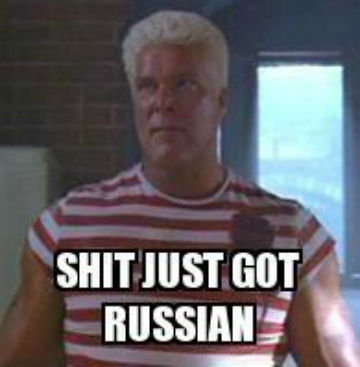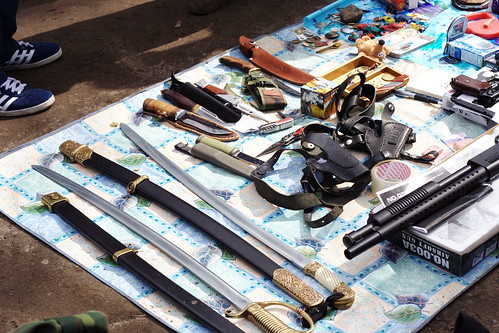Yesterday, I was talking to Nastya, one of the Russians who has been employing me. Her response to being told that not all homeless people in London are immigrants who couldn't find work:
"But I thought your government cared about homeless people?"
-made me realise that I am beyond the point of culture shock in Russia, as westernised a city as St Petersburg is.
On Saturday we went to Udelnaya market, Petersburg's largest open-air flea market, seeking Soviet relics and weird Russian behaviour. We were justly rewarded. There are lots of counterfeit products which seems to put the sellers on edge and I even got told:
"Girl, you can't look at everything without buying!" after a minute or so of browsing a stall. I quickly moved on.
I was too intimidated by the shouting Russians and collections of weapons to take pictures. So, I found some pictures on the Internet to give an idea of the market.
To get to the real gems, you have to walk through rows of metal huts with jumbled piles of clothes, which you can see babushkas expertly sifting through and discarding. There are lots of mannequins with different facial hair scribbled in permanent marker. My personal favourite was the obviously male head with Sharpied eyeliner and lipstick, under a bedraggled wig and a woman's hat.
The market as we saw it looked like this, but busier and slushier. The mud had no effect on the babushkas in man's boots trekking through it to hawk wares or argue over prices. The stalls turned in to ramshackle tables covered in coin collections, decorative spoons, various nuts and tools and the odd statue of "tribal" people in compromising positions.
Products ranged from some lovely jewellery depicting snakes and frogs to a beautiful cabinet with a picture of Stalin in front of an idyllic Soviet peasant sky. There was also a gigantic cast-iron profile of Lenin's head.
In the ramshackle-table part of the market were a lot of collections of army uniforms, galoshes and helmets. The stalls were often set up like a stage set or someone's attic and we wondered how many of those kept at the back were bullet-ridden war souvenirs.
Towards the end of the market, what looked like the contents of people's attics/a psychopath's shed were laid out on wet cardboard or cloth in the midst of the slush. There were little treasures like battered old suitcases and a miniature teapot which I didn't buy because it was priced at 600r (£12!) and haggling was an arduous prospect.
One canvas artfully displayed a selection of antlers, with one mounted deer's head being the priciest item. Later on we found a wolverine's skinned face among the broken pieces of a child's doll (all present) and a small pistol.
Weapons were fairly popular there. The shock of seeing the first collection of machetes wore off and our interest was only mildly piqued by the grenades, bullets, rifles and samurai swords laid out for sale.
Large men in leather jackets toasted the day with thermoses of tea or mugs of vodka as we listened to people enquiring about samovars or loudly sounding a strange wooden horn that sounded like a didgeridoo.
It is largely Russians who frequent this market - we tried to keep quiet and go incognito as far as possible. The only real signs of tourism are the many little statues of Soviet figures, and the counterfeit Royal Mail jackets hanging on a rack. I have yet to actually see a Russian dressed as a postman.
Earlier this week we finally went to the Kunstkamera museum - the first museum in Russia, which began with the collection of Peter the Great. It's on the bank of the Neva, across from the Hermitage. Although its main exhibitions are about indigenous people from different countries, from Eskimos to Iriquois, its main attraction for tourists is Peter's penchant for pickled foetuses.
Unfortunately, we didn't find the medieval torture instruments I'd heard so much about. There was a lovely collection of coloured beetles, but it did little to detract from the foetus-induced revulsion. I tried to ease my way into the exhibition by looking at a display about Peter I, my eyes flicking between the items and their descriptions. I suddenly realised that below Peter's portrait was a child's head in a jar.
After that shock I decided to wander over to the foetal displays. In both cabinets there was also a large fish pinned above the jars. I assume the organisers thought it would blend in. Apparently Peter ordered malformed, still-born infants to be sent over from all over the world, in an attempt to debunk superstitions of monsters and later displayed them as accidents of nature.
There were also some very nice pictures from Tibet, so it's not all doom and preserved limbs.
My week ended in a strange way: last night, as I was walking back from the supermarket, a strange man started telling me that something had fallen behind me. I confusedly wondered if I had dropped something, when his friend smiled, tapped my arm and said:
'Это шутка - It's a joke'. Then as we began to cross the road, his friend held the rose he was carrying out to me and said:
'А это вам - This is for you'
I thanked him and as I walked home, some boys I passed shouted 'Ах, красивая роза - Ah, beautiful rose!'
That never happens in England.
"But I thought your government cared about homeless people?"
-made me realise that I am beyond the point of culture shock in Russia, as westernised a city as St Petersburg is.
On Saturday we went to Udelnaya market, Petersburg's largest open-air flea market, seeking Soviet relics and weird Russian behaviour. We were justly rewarded. There are lots of counterfeit products which seems to put the sellers on edge and I even got told:
"Girl, you can't look at everything without buying!" after a minute or so of browsing a stall. I quickly moved on.
I was too intimidated by the shouting Russians and collections of weapons to take pictures. So, I found some pictures on the Internet to give an idea of the market.
To get to the real gems, you have to walk through rows of metal huts with jumbled piles of clothes, which you can see babushkas expertly sifting through and discarding. There are lots of mannequins with different facial hair scribbled in permanent marker. My personal favourite was the obviously male head with Sharpied eyeliner and lipstick, under a bedraggled wig and a woman's hat.
The market as we saw it looked like this, but busier and slushier. The mud had no effect on the babushkas in man's boots trekking through it to hawk wares or argue over prices. The stalls turned in to ramshackle tables covered in coin collections, decorative spoons, various nuts and tools and the odd statue of "tribal" people in compromising positions.
Products ranged from some lovely jewellery depicting snakes and frogs to a beautiful cabinet with a picture of Stalin in front of an idyllic Soviet peasant sky. There was also a gigantic cast-iron profile of Lenin's head.
In the ramshackle-table part of the market were a lot of collections of army uniforms, galoshes and helmets. The stalls were often set up like a stage set or someone's attic and we wondered how many of those kept at the back were bullet-ridden war souvenirs.
Towards the end of the market, what looked like the contents of people's attics/a psychopath's shed were laid out on wet cardboard or cloth in the midst of the slush. There were little treasures like battered old suitcases and a miniature teapot which I didn't buy because it was priced at 600r (£12!) and haggling was an arduous prospect.
One canvas artfully displayed a selection of antlers, with one mounted deer's head being the priciest item. Later on we found a wolverine's skinned face among the broken pieces of a child's doll (all present) and a small pistol.
Weapons were fairly popular there. The shock of seeing the first collection of machetes wore off and our interest was only mildly piqued by the grenades, bullets, rifles and samurai swords laid out for sale.
Large men in leather jackets toasted the day with thermoses of tea or mugs of vodka as we listened to people enquiring about samovars or loudly sounding a strange wooden horn that sounded like a didgeridoo.
It is largely Russians who frequent this market - we tried to keep quiet and go incognito as far as possible. The only real signs of tourism are the many little statues of Soviet figures, and the counterfeit Royal Mail jackets hanging on a rack. I have yet to actually see a Russian dressed as a postman.
 |
| The Neva - like the Thames but MASSIVE |
Unfortunately, we didn't find the medieval torture instruments I'd heard so much about. There was a lovely collection of coloured beetles, but it did little to detract from the foetus-induced revulsion. I tried to ease my way into the exhibition by looking at a display about Peter I, my eyes flicking between the items and their descriptions. I suddenly realised that below Peter's portrait was a child's head in a jar.
After that shock I decided to wander over to the foetal displays. In both cabinets there was also a large fish pinned above the jars. I assume the organisers thought it would blend in. Apparently Peter ordered malformed, still-born infants to be sent over from all over the world, in an attempt to debunk superstitions of monsters and later displayed them as accidents of nature.
 |
| One of the less gruesome displays |
My week ended in a strange way: last night, as I was walking back from the supermarket, a strange man started telling me that something had fallen behind me. I confusedly wondered if I had dropped something, when his friend smiled, tapped my arm and said:
'Это шутка - It's a joke'. Then as we began to cross the road, his friend held the rose he was carrying out to me and said:
'А это вам - This is for you'
 |
| Stunned bag-lady |
That never happens in England.






No comments:
Post a Comment